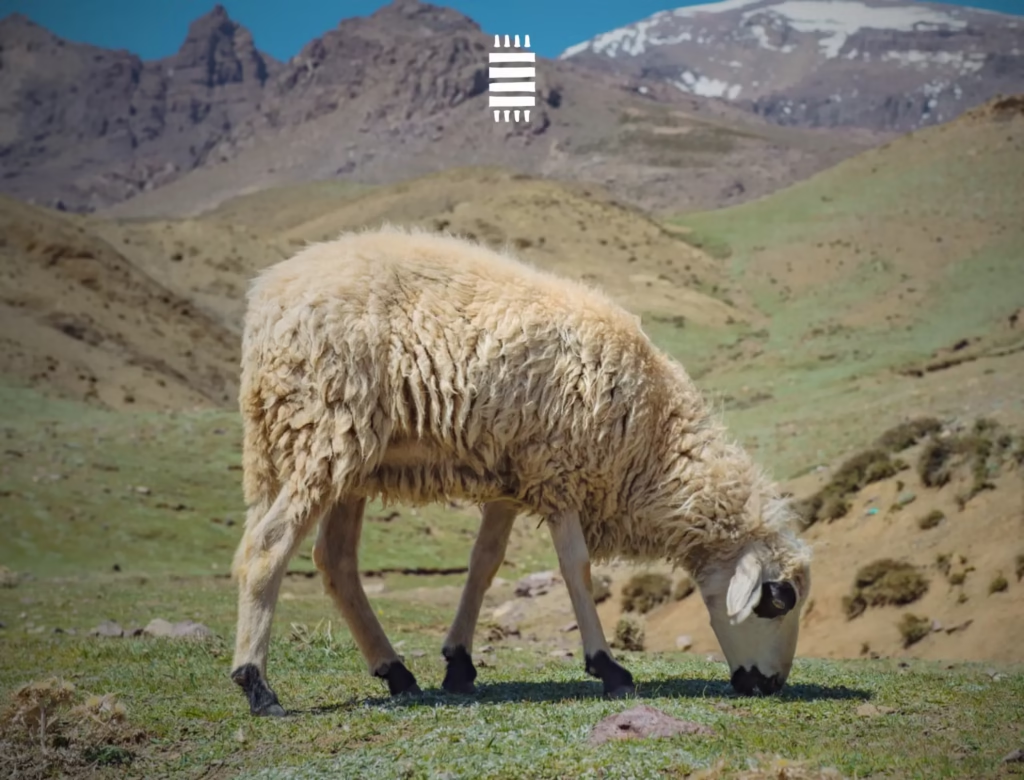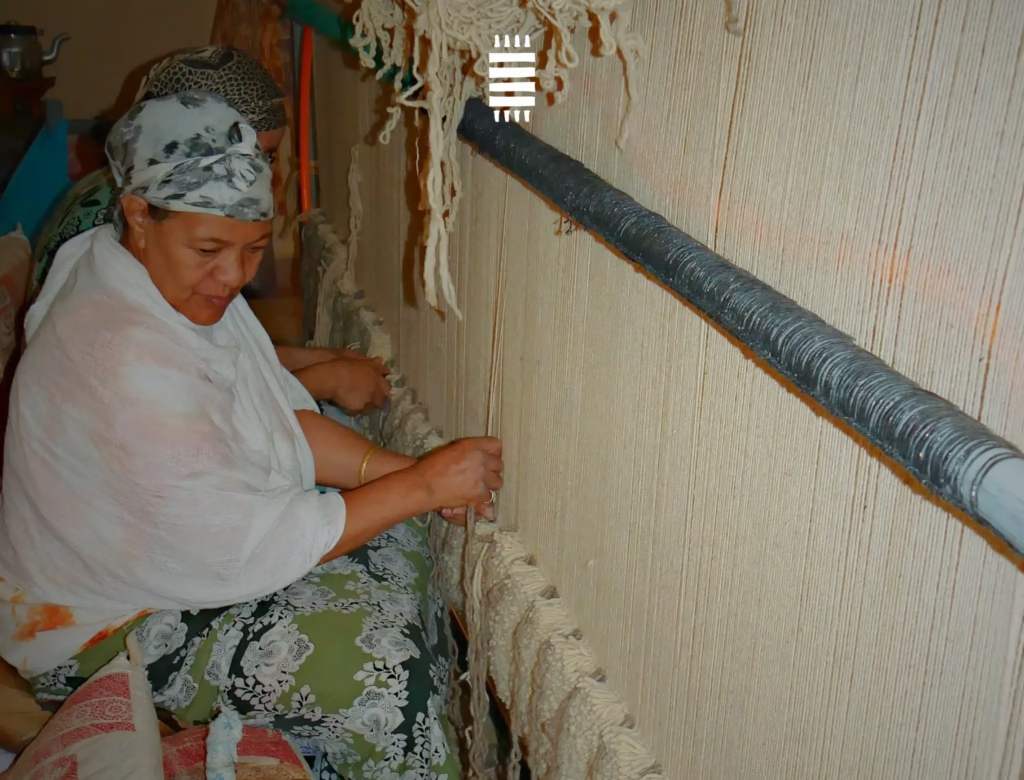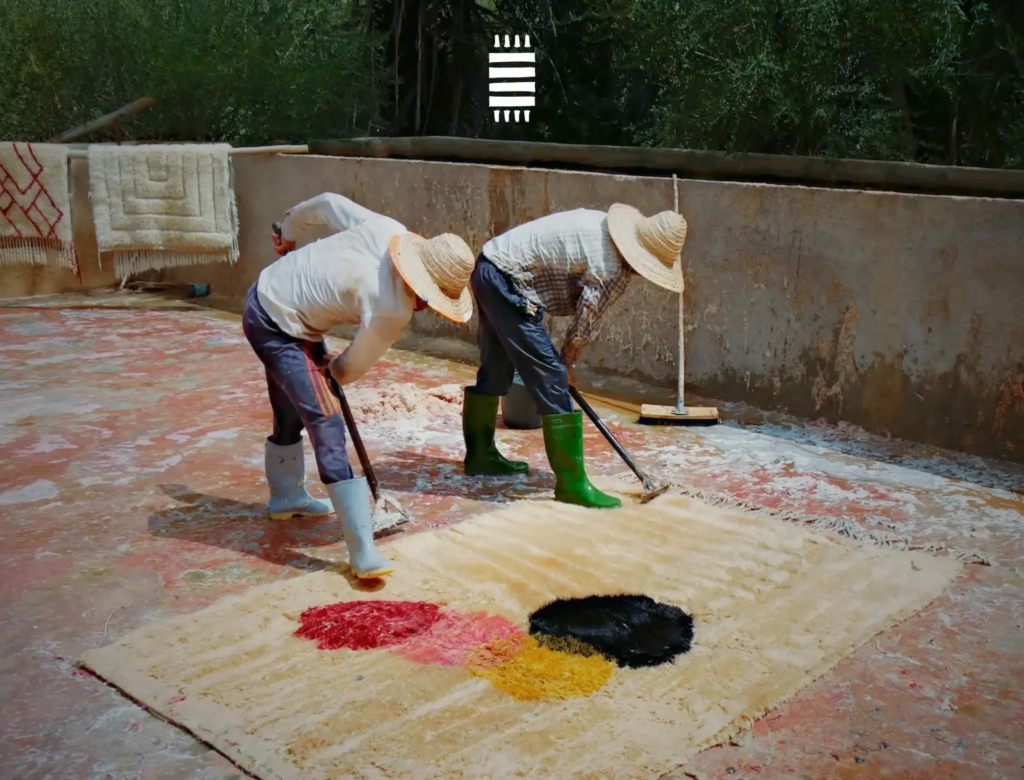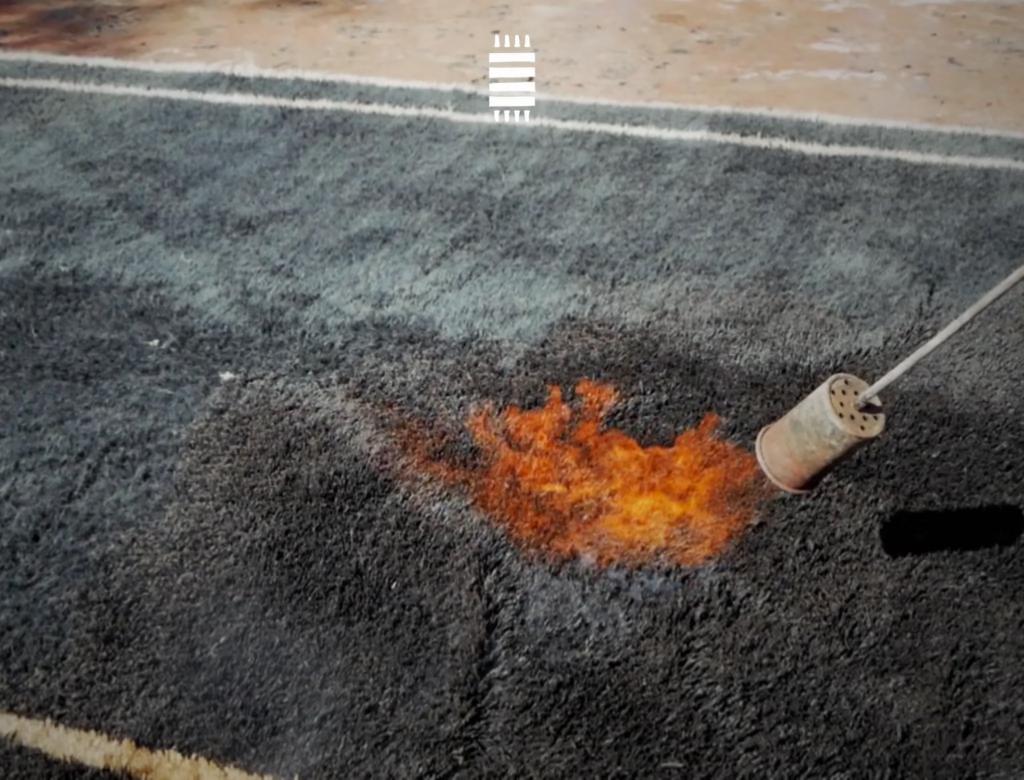Curious about the Moroccan rug making process?
At Wool Heritage, each rug is crafted by hand in Mrirt, a small town in Morocco’s Middle Atlas Mountains where rug making is more than tradition. From shearing the sheep to tightening the last knot, every step of the process is done by our team, in-house, using techniques passed down through generations of Amazigh women.

This guide shows you how each Moroccan rug is made, step by step. From freshly sheared wool to a finished piece ready for your home.
Table of Contents
A Living Craft Passed Down by Women of the Atlas
Moroccan rug making is more than craft, it is memory, resilience, and art combined. In villages like Mrirt, Amazigh women are the keepers of this heritage. Each rug is not just handmade but heart-made, carrying the marks of its weaver’s life, region, and identity.

In Mrirt and across the Atlas, rug making is a tradition passed through the hands of women. Most weavers begin as young girls, watching and practicing beside older relatives. Over time, they learn the rhythm of knotting, the meaning of patterns, and the patience the craft demands. These skills are not taught in schools. They are lived, repeated, and remembered, becoming part of daily life.
The Complete Process of Moroccan Rug Making
At Wool Heritage, we continue this ancestral process with care and precision. Here is how we make every rug from beginning to end.
1. The Wool and the Sheep

The process begins with sourcing high-quality wool from sheep raised in the mountains surrounding Mrirt. The cold climate produces dense, warm fleece that is ideal for rug making. In spring, the sheep are sheared by hand in calm conditions. The wool is then left to air out and rest.
Once dry, the wool is sorted by hand. Our artisans select it based on purity, fiber length, and texture. This step ensures that only the best wool moves forward to washing and spinning.
🔗 See how the wool is sourced: The Wool and the Sheep →
2. Preparing the Wool
The raw wool goes through a natural cleaning process using cold water to remove dust and oils without chemicals. After washing, it is spread under the sun to dry slowly and evenly.
Once clean, the wool is spread out in the open air and dried under the sun. This natural drying method helps maintain the wool’s strength and purity. When dry, the fibers are combed with wooden tools to untangle them. This process, known as carding, aligns the fibers and prepares them for spinning.
Spinning is done by hand using a traditional spindle. The spinner draws out the fibers with one hand while twisting them with the other, forming even threads ready for dyeing. This method has been passed down through generations and is still practiced today in villages like Mrirt.
🔗 Step inside the wool preparation process: Preparing the Wool →
3. Dyeing the Wool
Once the wool is spun into thread, it is ready to be dyed using natural ingredients prepared by hand. In regions like the Middle Atlas, dyers use traditional plant-based sources such as henna, saffron, pomegranate peel, indigo leaves, and walnut husks. These materials are gathered, dried, and stored carefully to preserve their color properties.
The dyeing process begins by boiling the ingredients in large pots until they release their natural pigment. The wool is then soaked in the colored water and gently moved by hand to ensure the color spreads evenly across the thread. The final result depends on many factors, including the temperature of the water, the amount of pigment, and the amount of time the wool is left to absorb the color.
In this step, the wool starts to carry meaning. Each color is linked to Amazigh culture. Red can symbolize life or fertility. Yellow is used for blessings and protection. Blue often reflects the sky or spirituality. These meanings are not random. They are passed through generations and reflected in every piece.
🔗 See how nature gives color to Moroccan rugs:
4. Preparing the Warp Base
Before the loom is assembled, we start with a step known in our workshop as preparing the warp base. This work is done on the ground, where two women work together to stretch, align, and roll the warp threads that will form the structure of the rug.
These threads are relatively fine compared to the other threads used for knotting, yet they are strong enough to ensure the tension and durability needed to support thousands of knots. The threads are measured precisely and grouped to match the planned size and design of the rug. This step is essential for guaranteeing stability and symmetry in the finished piece.
5. Setting the Loom
Once the warp threads are ready, we assemble the wooden loom. It is installed in a quiet corner of our workspace and adjusted to match the intended size of the rug.
The warp threads from the previous step are then mounted and tightened. This creates the vertical structure on which the entire rug will be built.
🔗 See how each rug begins on the loom:
6. Weaving the Story

Weaving begins at the base of the loom. Each rug is knotted by hand using the dyed wool prepared earlier. The weaver ties each knot carefully, row by row, building the design from memory and emotion.
At Wool Heritage, we honor the ancestral visual language of Amazigh symbols, but we also bring in thoughtful modern design. Each rug is created by our team to reflect both heritage and contemporary interiors.
The patterns and symbols are not decorative. They carry messages about protection, nature, and the life of the artisan. Each finished rug is a story told in wool.
🔗 Explore the craft of weaving Moroccan rugs:
7. Washing the Rug
The final stage of rug making at Wool Heritage is both physical and delicate. It is led by the men in our team, whose strength and precision are essential to completing the rug with care.

Washing begins outside, where the rug is gently burned to remove loose fibers and bring clarity to the design. This is done slowly by hand, using a small flame passed over the wool to smooth the surface without harming the knots beneath.

Once the burning is complete, cold water is poured over the rug in several rounds to loosen dust and refresh the wool. The men then scrub the surface using wide traditional brooms, working with rhythm and force to clean the weave and reveal its depth.
After rinsing, the rug is left to dry naturally under the sun. The warmth and light help fix the colors and restore the softness of the fibers. When dry, the rug is complete and ready to enter your home, carrying the story of every hand that shaped it.
🔗 See how we finish each rug with water and sun:
From Tradition to Home
Each Moroccan rug at Wool Heritage is more than a product. It is a living story that begins with the sheep in the Atlas Mountains and moves through the skilled hands of Amazigh women who clean, spin, dye, and weave every thread.
If you’ve followed this process, we welcome you to discover the results. Each rug in our collection has taken this same path from raw wool to a timeless piece made to last for generations.
We do everything in-house, without outsourcing, and without shortcuts. Every knot, every detail, reflects care, memory, and ancestral knowledge.
👉 View our handmade Moroccan rugs